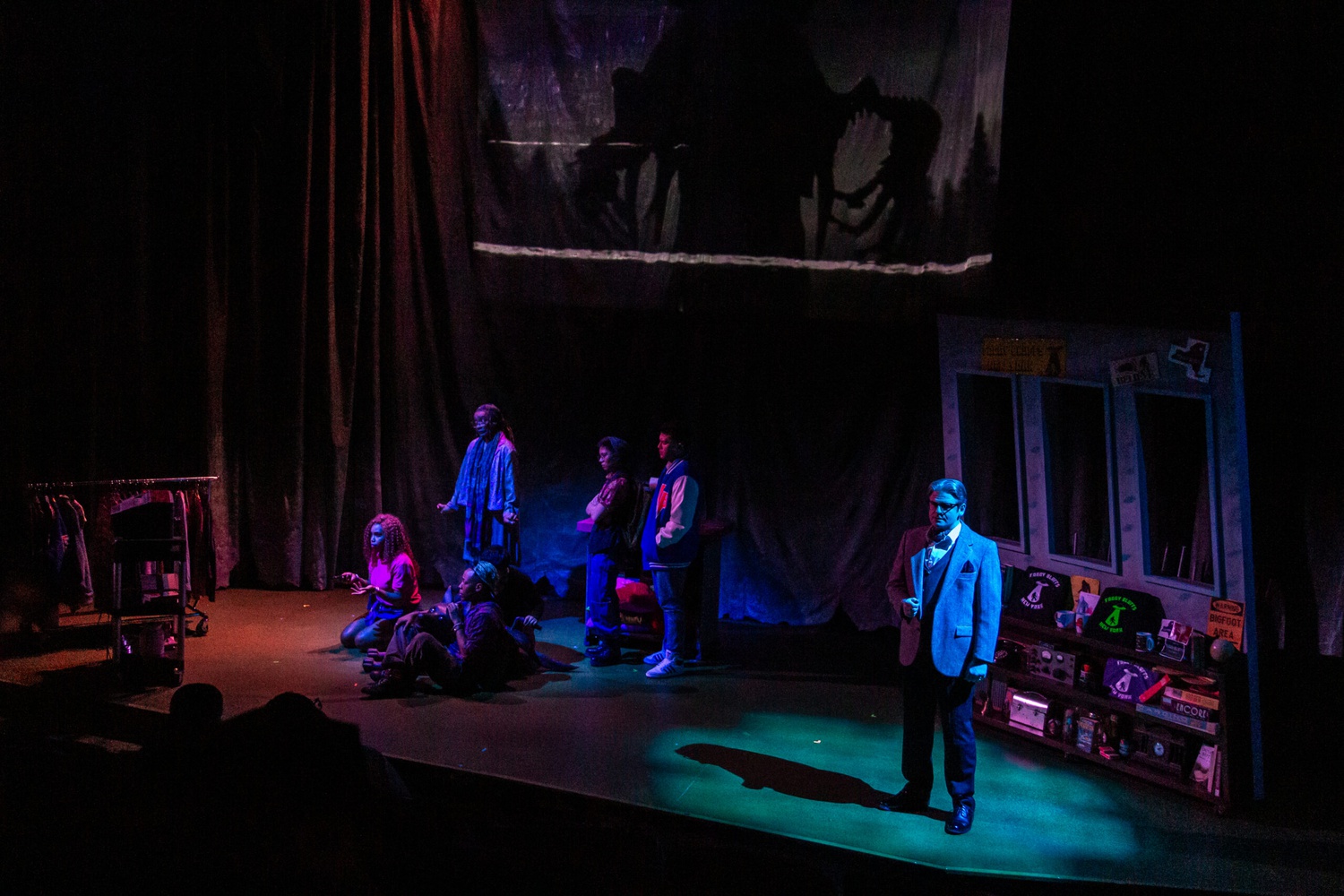
News
Progressive Labor Party Organizes Solidarity March With Harvard Yard Encampment

News
Encampment Protesters Briefly Raise 3 Palestinian Flags Over Harvard Yard

News
Mayor Wu Cancels Harvard Event After Affinity Groups Withdraw Over Emerson Encampment Police Response

News
Harvard Yard To Remain Indefinitely Closed Amid Encampment

News
HUPD Chief Says Harvard Yard Encampment is Peaceful, Defends Students’ Right to Protest
‘The Interrobangers’ Review: The Mystery of the Plot Underwhelms

M Sloth Levine’s “The Interrobangers” attempts to evoke a familiar nostalgia with its parallels to the classic TV program “Scooby Doo,” which follows a gang of friends and man’s best friend solving mysteries. However, Levine’s play takes a modern approach by altering the plot to be a queer coming-of-age story centered around identity and community. The production debuted on Jan. 6 in partnership with The Theater Offensive and the Boston Public Library. The unique ambiance of the play’s location of Rabb Hall at Boston Public Library adds to the up-to-date feel, and the pay-what-you-want tickets make the show accessible to all who want to attend. Yet, while “The Interrobangers” is an interesting and contemporary take on beloved animated series “Scooby-Doo,” the writing suffers from ambitious stretching in too many directions, creating a confusing and unsatisfying plotline.
From lighting to set, the technical production of the play remains engaging throughout the performance. Early on, the play showcases their strong tech with an upstage projection that shows a timeline of events via fabricated news headlines. However, the best tech feature is undoubtedly the seamless transitions between scenes, as the stage crew frequently installed very complex sets. At the show’s start, the cast and crew manage to transform a blank stage into an intricate scene of a thrift shop — complete with clothing racks, a cashier station, and shelves of merchandise — within seconds. The crew does not back down from the challenge of replicating the classic appearance of The Mystery Machine, either. The first appearance of a fold out replica van constructed with PVC Pipe — creating a hollow image of a full-sized van with realistic finishes such as a steering wheel and backup mirror — elicits gasps of excitement from the audience.
Apart from standout tech behind the scenes, many of the onstage performances are enjoyable as well. Overall, the acting of the play is wonderful, despite some small inconsistencies. For instance, Anderson Stinson III’s character Zodiac starts out with an incredible rendition of an iconic Shaggy accent that toes the line between recognizable and over the top, yet the accent disappears as the play progresses.
The strongest acting of the program actually comes from a character without a single line. A daunting question for any fan of the old show is: How is the play going to transfer the lively energy of Scooby-Doo to the stage? As a result, the emergence of a puppet dog is met with several eyebrow raises from audiences. Nonetheless, Jupiter Lê handles Hoover’s puppet superbly. He truly captures every detail of a live animal, from breathing while sleeping, to a rigid posture, to active listening while still presenting an energetic demeanor. While the action scenes display very impressive movement, the small details are what brings Hoover’s character an added level of authenticity. Not only is the performance incredibly lifelike, but the puppet design from Amanda Gibson perfectly enables Lê’s dynamic display.
Despite the performance’s strengths, at times the dialogue falls flat and lacks emotional depth. The show suffers from having multiple side storylines without fully fleshing them out, and does not plant the seeds for its side stories to make sense. A notable instance of this shortcoming is the romance between Zodiac and Hank Mason (Jay Connolly), which emerges halfway through the show without any romantic tension between the two characters previously. The two have very few interactions and then around the halfway point of the program, some characters start pointing out a budding romance between the two. However, this romantic tension hasn’t been developing from the onset of the play and the result is a dynamic that feels fake and rushed. While this dynamic culminates in a tender moment between the two, they are both under the influence of substances during the scene.
This reflects a greater problem: The plot often resorts to impaired thinking from substance use, rather than taking the time to peel back the layers of characters and form connections between them. This dynamic makes scenes intended to be impactful feel insignificant by chalking it up to a drug-induced word vomit rather than an emotional vulnerability.
Furthermore, while the story tries to remain mysterious, this effect is confusing for audiences. The entire premise of the show revolves around a mystery deeply rooted in Zodiac’s past, and the attempted preservation of this mystery causes a continuously changing plot that doesn’t allow the audience to ever get a grip on the events of the show. There are cliffhangers after cliffhangers without any questions ever truly being answered. The plot attempts to leave watchers puzzled, but perhaps takes a step too far by leaving them asking: What is happening? Coupled with an ambiguous ending, audiences may be left with a feeling of uncertainty of the events of the show’s two-hour run time.
Levine’s play is nevertheless an important work of art in a greater conversation about queer voices and narratives being told on stage. The visibility of these struggles brought to light by the theater highlights a greater truth about LGBTQ+ experience in the real world. However, in “The Interrobangers,” the ambition in the writing contributes to a lack of narrative depth and connection with the audience.
“The Interrobangers” runs through Feb. 24 at the Boston Public Library.
—Staff writer Ava E. Silva can be reached at ava.silva@thecrimson.com.
Want to keep up with breaking news? Subscribe to our email newsletter.
